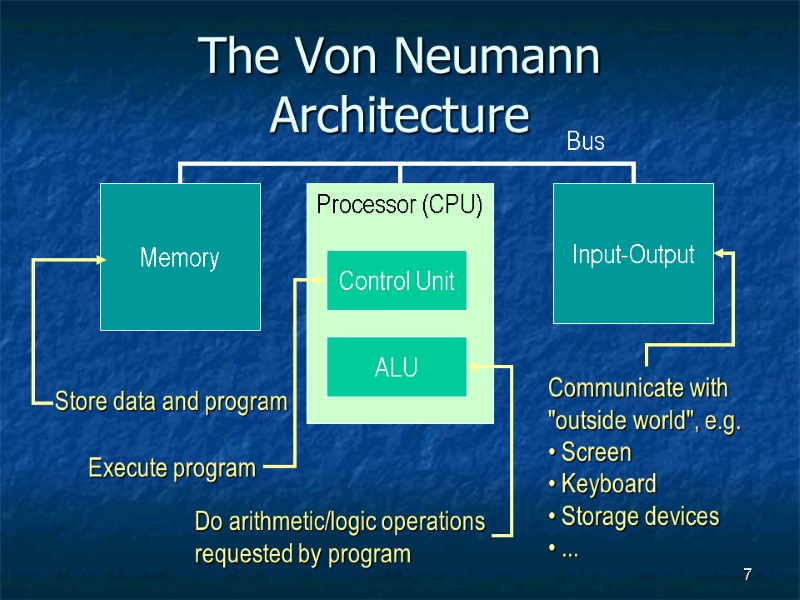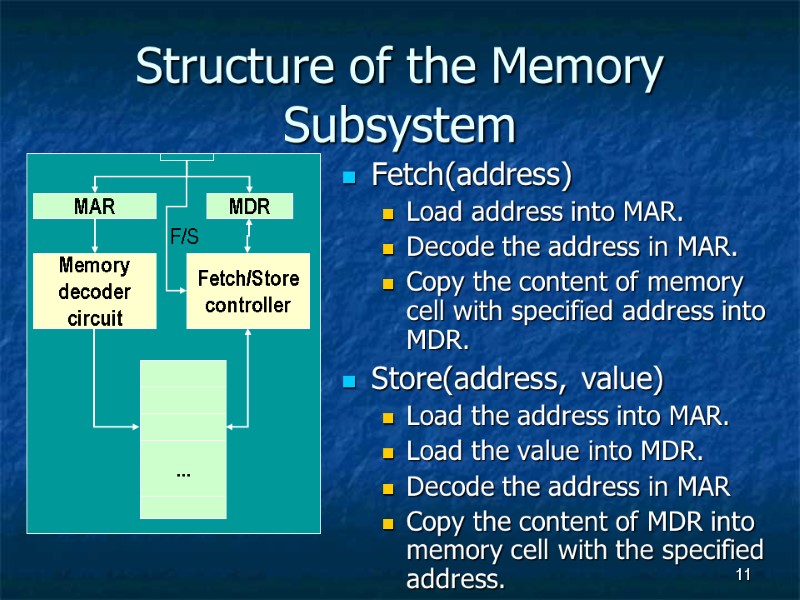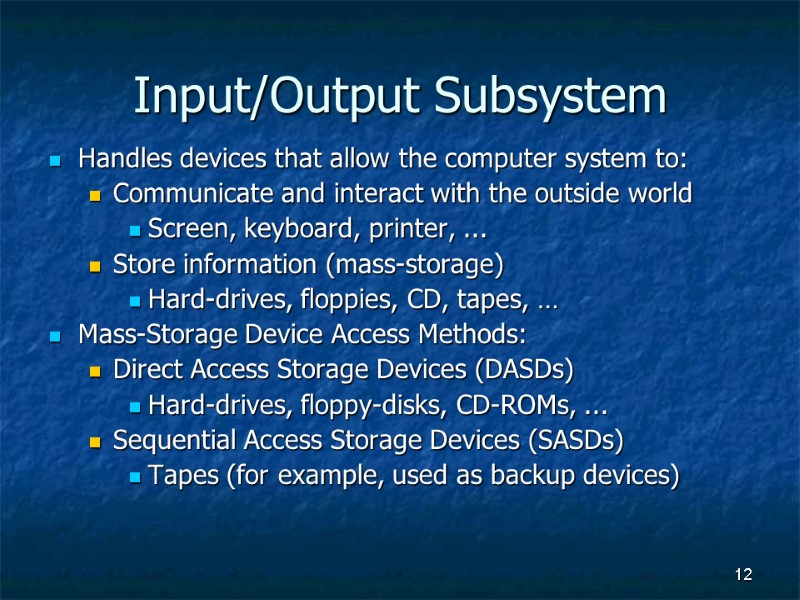CPU How It Works 2 Generic Block Diagram


CPU How It Works

2 Generic Block Diagram CPU Memory Input Output Address Bus Data Bus

Hardware

The Von Neumann Architecture Von Neumann Architecture

5 Designing Computers All computers more or less based on the same basic design, the Von Neumann Architecture!

6 The Von Neumann Architecture Model for designing and building computers, based on the following three characteristics: The computer consists of four main sub-systems: Memory ALU (Arithmetic/Logic Unit) Control Unit Input/Output System (I/O) Program is stored in memory during execution. Program instructions are executed sequentially.

7 The Von Neumann Architecture Memory Processor (CPU) Input-Output Control Unit ALU Bus

8 Memory Subsystem Memory, also called RAM (Random Access Memory), Consists of many memory cells (storage units) of a fixed size. Each cell has an address associated with it: 0, 1, … All accesses to memory are to a specified address. A cell is the minimum unit of access (fetch/store a complete cell). The time it takes to fetch/store a cell is the same for all cells. When the computer is running, both Program Data (variables) are stored in the memory.

9 Memory Size / Speed Typical memory in a personal computer (PC): 64MB - 256MB Memory sizes: Kilobyte (KB) = 210 =1,024 bytes ~ 1 thousand Megabyte(MB) = 220 =1,048,576 bytes ~ 1 million Gigabyte(GB) = 230 = 1,073,741,824 bytes ~ 1 billion Memory Access Time (read from/ write to memory) 50-75 nanoseconds (1 nsec. = 0.000000001 sec.) RAM is volatile (can only store when power is on) relatively expensive

10 Operations on Memory Fetch (address): Fetch a copy of the content of memory cell with the specified address. Non-destructive, copies value in memory cell. Store (address, value): Store the specified value into the memory cell specified by address. Destructive, overwrites the previous value of the memory cell. The memory system is interfaced via: Memory Address Register (MAR) Memory Data Register (MDR) Fetch/Store signal

11 Structure of the Memory Subsystem Fetch(address) Load address into MAR. Decode the address in MAR. Copy the content of memory cell with specified address into MDR. Store(address, value) Load the address into MAR. Load the value into MDR. Decode the address in MAR Copy the content of MDR into memory cell with the specified address. MAR MDR ... Memory decoder circuit Fetch/Store controller F/S

12 Input/Output Subsystem Handles devices that allow the computer system to: Communicate and interact with the outside world Screen, keyboard, printer, ... Store information (mass-storage) Hard-drives, floppies, CD, tapes, … Mass-Storage Device Access Methods: Direct Access Storage Devices (DASDs) Hard-drives, floppy-disks, CD-ROMs, ... Sequential Access Storage Devices (SASDs) Tapes (for example, used as backup devices)

13 I/O Controllers Speed of I/O devices is slow compared to RAM RAM ~ 50 nsec. Hard-Drive ~ 10msec. = (10,000,000 nsec) Solution: I/O Controller, a special purpose processor: Has a small memory buffer, and a control logic to control I/O device (e.g. move disk arm). Sends an interrupt signal to CPU when done read/write. Data transferred between RAM and memory buffer. Processor free to do something else while I/O controller reads/writes data from/to device into I/O buffer.

14 I/O controller Structure of the I/O Subsystem I/O Buffer Control/Logic I/O device Data from/to memory Interrupt signal (to processor)

15 The ALU Subsystem The ALU (Arithmetic/Logic Unit) performs mathematical operations (+, -, x, /, …) logic operations (=, <, >, and, or, not, ...) In today's computers integrated into the CPU Consists of: Circuits to do the arithmetic/logic operations. Registers (fast storage units) to store intermediate computational results. Bus that connects the two.

16 Structure of the ALU Registers: Very fast local memory cells, that store operands of operations and intermediate results. CCR (condition code register), a special purpose register that stores the result of <, = , > operations ALU circuitry: Contains an array of circuits to do mathematical/logic operations. Bus: Data path interconnecting the registers to the ALU circuitry. ALU circuitry R0 R1 R2 Rn

17 The Control Unit Program is stored in memory as machine language instructions, in binary The task of the control unit is to execute programs by repeatedly: Fetch from memory the next instruction to be executed. Decode it, that is, determine what is to be done. Execute it by issuing the appropriate signals to the ALU, memory, and I/O subsystems. Continues until the HALT instruction

18 Machine Language Instructions A machine language instruction consists of: Operation code, telling which operation to perform Address field(s), telling the memory addresses of the values on which the operation works. Example: ADD X, Y (Add content of memory locations X and Y, and store back in memory location Y). Assume: opcode for ADD is 9, and addresses X=99, Y=100 00001001 0000000001100011 0000000001100100 Opcode (8 bits) Address 1 (16 bits) Address 2 (16 bits)

19 How does this all work together? Program Execution: PC is set to the address where the first program instruction is stored in memory. Repeat until HALT instruction or fatal error Fetch instruction Decode instruction Execute instruction End of loop

20 Program Execution (cont.) Fetch phase PC --> MAR (put address in PC into MAR) Fetch signal (signal memory to fetch value into MDR) MDR --> IR (move value to Instruction Register) PC + 1 --> PC (Increase address in program counter) Decode Phase IR -> Instruction decoder (decode instruction in IR) Instruction decoder will then generate the signals to activate the circuitry to carry out the instruction

21 Program Execution (cont.) Execute Phase Differs from one instruction to the next. Example: LOAD X (load value in addr. X into register) IR_address -> MAR Fetch signal MDR --> R ADD X left as an exercise
9476-ict_grade_11__11.1a_system_fundamentals_neuman_architecture_2.ppt
- Количество слайдов: 21

